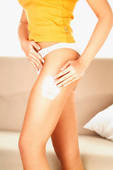 It’s one of the most common figure flaws and one of the hardest to get rid of – dimpled, lumpy cellulite on the thighs, legs, stomach, and arms. Regardless of diet, exercise, or age, over 80% of women – by some estimates as high as 90% – have visible cellulite. Last year, according to ABC News, over $100 million was spent on cellulite reduction in America. There are two reasons for the outpouring:
It’s one of the most common figure flaws and one of the hardest to get rid of – dimpled, lumpy cellulite on the thighs, legs, stomach, and arms. Regardless of diet, exercise, or age, over 80% of women – by some estimates as high as 90% – have visible cellulite. Last year, according to ABC News, over $100 million was spent on cellulite reduction in America. There are two reasons for the outpouring:
* Unlike other fat, cellulite isn’t broken down by diet or exercise, and it is not clear why.
* Because no one knows exactly what causes it, there are few effective ways to reduce it.
New technologies are offering a promising twist to cellulite reduction, combining infrared light and radio frequency (RF) with massaging rollers to break up and smooth cellulite and also to stimulate collagen production and metabolism deep in the tissue for long-term results.
Describing Cellulite
Although cellulite is structurally the same as regular fat (adipose tissue), it builds up in a very different way. For cellulite, fat is layered in globular pockets under the skin, held in place by rigid connective tissues. The lumpy pockets of fat give cellulite its cobblestone appearance.
Cellulite is not broken down through diet or exercise the way normal fat deposits are. One theory holds that toxins and fluids are trapped in the pockets, which impair metabolism and keep the fat from being broken up. Additionally, cellulite production is tied to hormones, specifically estrogen, so things that cause hormone fluctuations – like pregnancy, puberty, menopause, even stress – can cause cellulite. Where and at what rate cellulite is formed is different for every person.
[ad#ad-6]
Diet and exercise can improve the situation somewhat by keeping overall body fat down and by keeping the underlying muscle firm. But even diet and exercise cannot remove, or improve, cellulite. Since cellulite doesn’t really go away, the appearance of cellulite gets worse over time, as more deposits build up. Cellulite Reduction Treatment
There are five major types of cellulite reduction therapy:
* Topical treatments: Lotions or creams usually work by using caffeine or some other stimulant to tighten the top skin layers. These are temporary effects.
* Mesotherapy: This is a series of injections of special medicines or homeopathic ingredients to stimulate metabolism. The main drawbacks are lingering soreness, bruising, and pain during the injections.
* Cosmetic surgery: There are a variety of possible surgical procedures like liposuction, which removes the fat deposits; subcision, which slices the upper skin layer, severing the connective tissues between the fat globules and the skin, and allows fluid to fill the pockets, making the cellulite look smoother; and fat transfer, which injects fat deposits to fill in the pockets and make the cellulite look smoother. Cosmetic surgery can effectively remove existing cellulite, but with potential side effects like infection, inflammation, pain, and recovery time.
* Endermology: This uses suction to break up the fat deposits, while massaging rollers smooth the cellulite, which decreases its appearance.
* Combination technology: This progressive treatment, based on heat energy and approved by the FDA in 2005, unites massaging rollers with heat from infrared and radio frequency (RF) to stimulate collagen production and reshape the cellulite. RF makes the heat go deeper, more safely, and adds a beneficial skin tightening effect that smoothes the overall appearance of the skin. The therapy feels similar to a deep tissue massage. Cellulite Reduction Treatment.
[ad#ad-5]

Leave a Reply